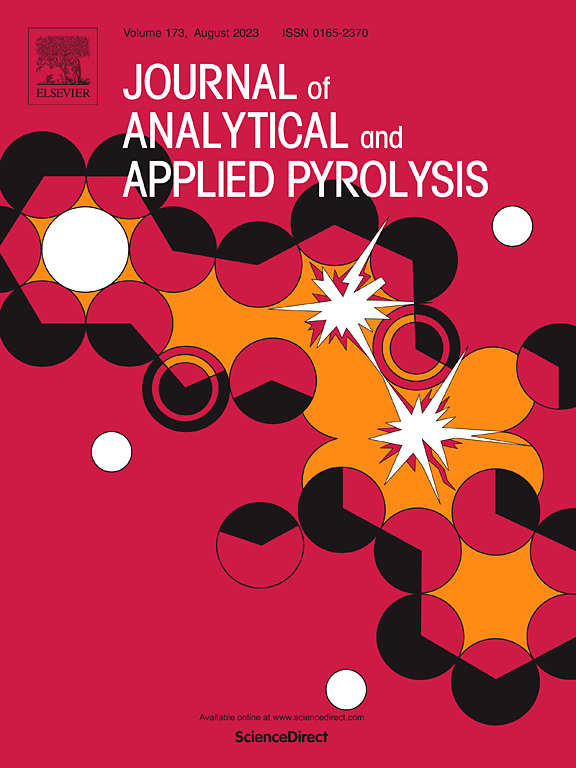In situ and ex situ catalytic microwave pyrolysis of biomass pellets using Ni/Al2O3 for hydrogen and bio-oil production
IF 5.8
2区 化学
Q1 CHEMISTRY, ANALYTICAL
引用次数: 0
Abstract
Four different biomass feedstocks, viz., rice straw (RS), sugarcane bagasse (BG), pine wood (PW), and Prosopis juliflora (PJ), were pyrolyzed in a microwave reactor at 800 W- 800 °C, and the hydrogen generation potential was assessed under different conditions using Ni/α-Al2O3 catalyst. Uniquely, four different configurations were evaluated in this study, which include non-catalytic pyrolysis of biomass in powder and pellet forms, and catalytic pyrolysis of biomass pellets in in-situ and ex-situ modes. The hydrogen yield was high in the case of biomass pellets and in the presence of catalyst. The general trend was: (biomass pellets) In-situ > (biomass pellets) Ex-situ > biomass pellets > powder biomass. The heating rates also followed the above trend for all biomass feedstocks. Gas yield increased by 2–10 % with pelletization of biomass, and 18–32 % with the use of catalyst due to efficient cracking of the pyrolysis vapours. The H2:CO (mol/mol) ratio was higher in the case of in-situ pyrolysis mode, and the trend was: BG (1.60) > PW (1.52) > RS (1.32) ≈ PJ (1.31). In-situ catalytic pyrolysis of PW pellets yielded high amount of hydrogen (39 vol%, 27.7 g/kgbiomass). In-situ catalytic pyrolysis mode was effective for higher hydrogen yield due to better contact of the pyrolysates with the Ni catalyst that effectively promoted water gas shift reaction. Ex-situ catalytic pyrolysis of biomass pellets produced high yield of CO+CO2. Detailed bio-oil composition analysis revealed that the selectivity to phenolics in the bio-oil obtained from biomass pellets (64–71 %) was more than that from biomass in powder form (51–61 %). Notably, in-situ catalytic pyrolysis of pellets resulted in a sharp decline in phenolic selectivity (22–45 %) accompanied by increased production of aliphatic oxygenates (38–52 %), and mild increase in aliphatic hydrocarbons. This study proves that microwave-assisted pyrolysis of biomass pellets is a promising strategy for hydrogen generation at high yields with good potential to reform the gases for further enhancement of hydrogen.
利用Ni/Al2O3原位和非原位催化微波热解生物质颗粒制氢和生物油
在 800 W- 800 °C 的微波反应器中热解了四种不同的生物质原料,即稻草 (RS)、甘蔗渣 (BG)、松木 (PW) 和糙米 (PJ),并使用 Ni/α-Al2O3 催化剂评估了不同条件下的制氢潜力。与众不同的是,本研究评估了四种不同的配置,包括粉末状和颗粒状生物质的非催化热解,以及生物质颗粒的原位和非原位催化热解。在有催化剂存在的情况下,生物质颗粒的产氢量较高。总的趋势是:(生物质颗粒)原位>;(生物质颗粒)非原位>;生物质颗粒>;粉末生物质。所有生物质原料的加热速率也遵循上述趋势。生物质颗粒化后,气体产量增加了 2-10%;使用催化剂后,由于热解蒸汽的高效裂解,气体产量增加了 18-32%。在原位热解模式下,H2:CO(摩尔/摩尔)的比率较高,其趋势如下:BG (1.60) > PW (1.52) > RS (1.32) ≈ PJ (1.31)。原位催化热解 PW 粒子可产生大量氢气(39 vol%,27.7 克/千克生物质)。原位催化热解模式能有效提高氢气产量,这是因为热解产物与镍催化剂的接触更好,能有效促进水气变换反应。生物质颗粒的原位催化热解产生了较高的 CO+CO2 产率。详细的生物油成分分析表明,从生物质颗粒中获得的生物油对酚类化合物的选择性(64-71%)高于从粉末状生物质中获得的生物油对酚类化合物的选择性(51-61%)。值得注意的是,颗粒原位催化热解导致酚类选择性急剧下降(22-45%),同时脂肪族含氧化合物的产量增加(38-52%),脂肪族碳氢化合物的产量轻微增加。这项研究证明,微波辅助生物质颗粒热解是一种前景广阔的高产氢策略,具有对气体进行重整以进一步提高氢气产量的良好潜力。
本文章由计算机程序翻译,如有差异,请以英文原文为准。
求助全文
约1分钟内获得全文
求助全文
来源期刊
CiteScore
9.10
自引率
11.70%
发文量
340
审稿时长
44 days
期刊介绍:
The Journal of Analytical and Applied Pyrolysis (JAAP) is devoted to the publication of papers dealing with innovative applications of pyrolysis processes, the characterization of products related to pyrolysis reactions, and investigations of reaction mechanism. To be considered by JAAP, a manuscript should present significant progress in these topics. The novelty must be satisfactorily argued in the cover letter. A manuscript with a cover letter to the editor not addressing the novelty is likely to be rejected without review.

 求助内容:
求助内容: 应助结果提醒方式:
应助结果提醒方式:


